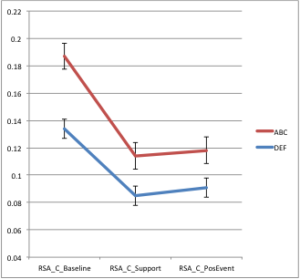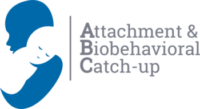Effects of ABC in Middle Childhood
We are now following children into middle childhood (8-10 years).
Attachment
At age 9 (7- 8 years after the intervention), children with whom we had intervened in infancy were asked to complete a self-report inventory that asks children to respond to 15 questions about their relationships with their parents (Kerns, 2001). Children indicated which one of two statements best describes them, such as “Some kids find it easy to trust their mom,” or “Other kids are not sure they can trust their mom,” and then to indicate if the statement they choose is “really like you” or “sort of like you.”
We found that children whose parents received the ABC intervention reported attachments to their parents that were significantly more secure (M = 3.49, SD = .38) than children whose parents received the control intervention (M = 3.28, SD = .47; Raby et al., in preparation).
Self-regulation: Autonomic nervous system activity
To assess whether children in the ABC intervention showed better-regulated autonomic nervous system activity, we had 9-year-old children engage in a challenging discussion with their parents that was designed to elicit negative emotions. Physiological data were recorded from sensors that monitored heart rate and breathing while children were at rest while they discussed a recent distressing event with the parent, and then while having a positive discussion.
Children in the ABC group showed lower heart rate and higher levels of respiratory sinus arrhythmia (RSA), reflecting better regulation of their autonomic nervous system, than children in the control group (see figure; Tabachnick et al., under review).

Neural activity
Electroencephalography (EEG) permits the assessment of neural function. As the cortex becomes more differentiated and specialized during development, there is a reduction in the proportion of low frequency band activity and increase in the proportion of high band frequency activity (high alpha and beta activity). Bick et al. (2018) found that children who had received the ABC intervention showed higher relatively beta activity than control children, consistent with a more mature cortex.
Brain activity
We also examined children’s brain activation through functional magnetic resonance imaging (fMRI) in each of two tasks when children were between 9 and 11 years old. In one task, children viewed photos of neutral and fearful faces.
The children with histories of CPS involvement showed more occipital cortex and fusiform gyrus activation when viewing fearful than neutral faces than a group of low-risk children, regardless of whether they were in the ABC or control group (Valadez, Tottenham, & Dozier, in preparation). However, children from the ABC group showed more prefrontal cortex and insula activation than children from the control intervention. This suggests that even though at some level ABC children are as threat-sensitive as control children, what differentiates ABC children is greater prefrontal cortex involvement, and thus better regulation of the threat.



